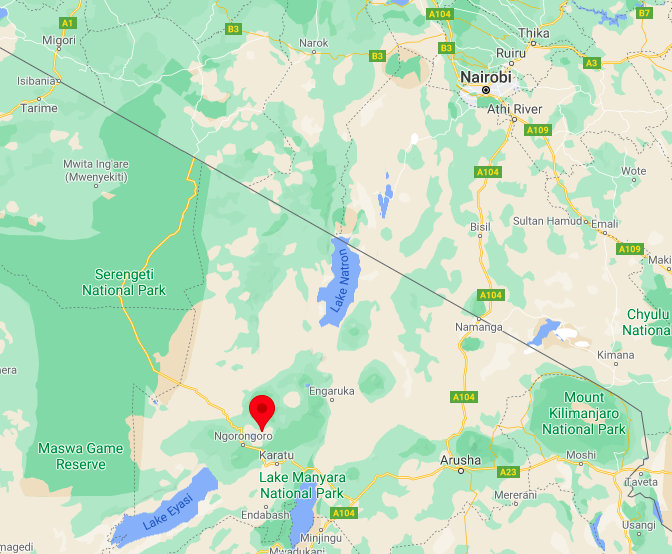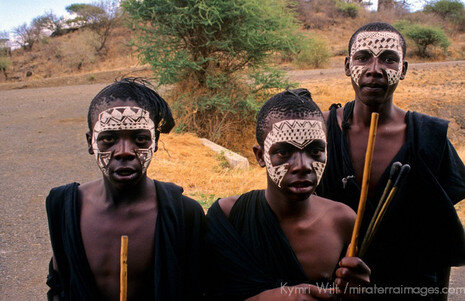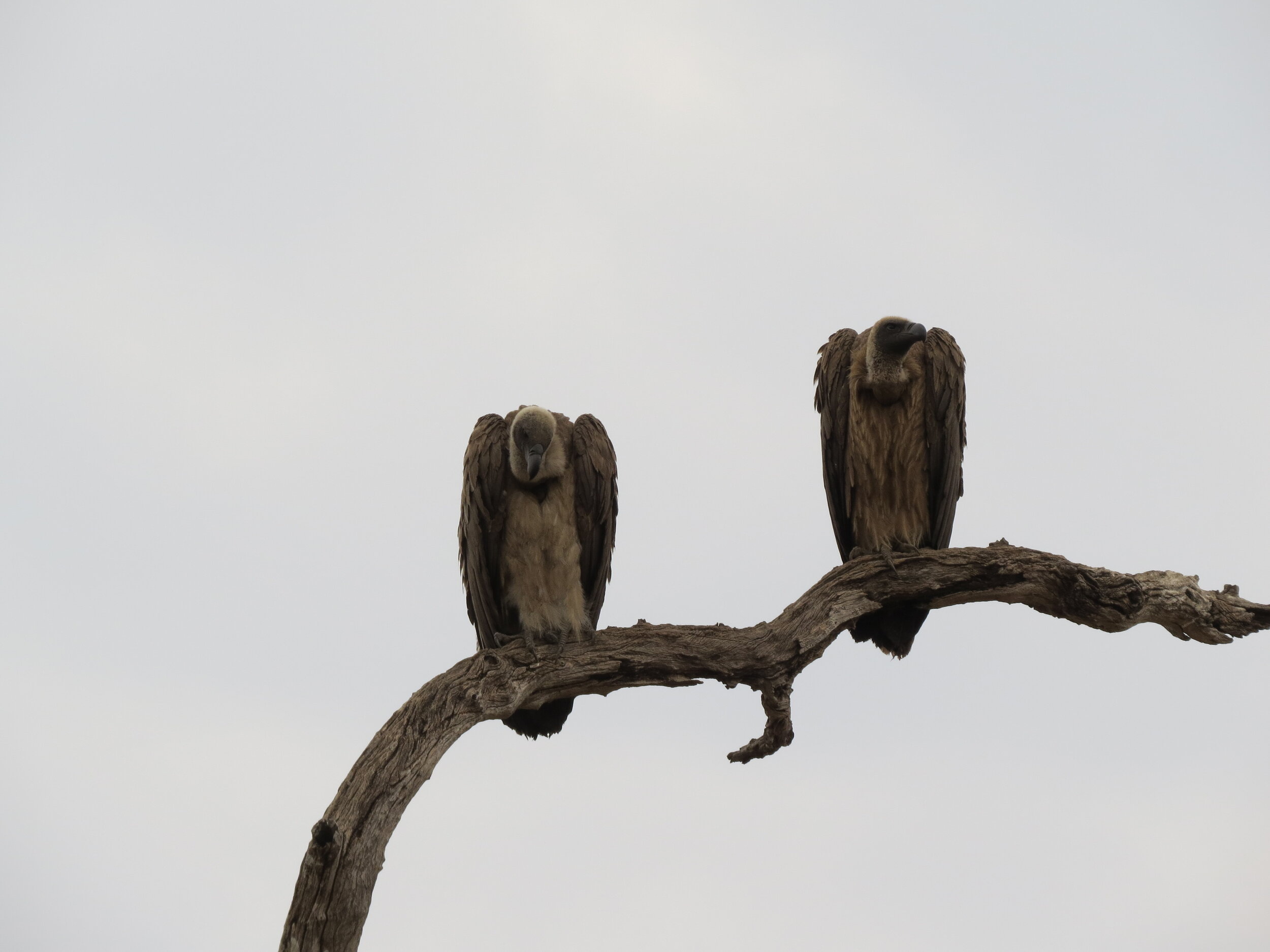I knew that the Serengeti was a long way from home. We flew and drove for many days to visit this lifelong dream of ours. But I had not realized that it would also involve driving hundreds of kilometers on the worst bumpy, dusty, rocky tracks… Bone jarring, teeth rattling miles of washboard tracks…. Everything in our car is covered in a layer of dust.
The pavement ends abruptly at the entrance gate to Ngorogoro Crater. The view of the crater is spectacular, with not much human influence in sight. But, for now, we drive right past the famous crater, to return later on our way back to Arusha. First, we will visit the Serengeti!
The track continues across hills and plains, up onto ever higher escarpments until we are at 2,400 meters. Once you reach Serengeti all you see if flat endless grasslands. We were anxious to take a photo of us at an entrance gate. All we saw was a crooked little wooden sign. But here we were, finally, in the Serengeti! I did have goosebumps to finally see this fabled place with my own eyes.
Within the first half hour we spot four lions. Then the impala. Herds of them. More and more animals until, on the second day, we caught up to migrating wildebeest and zebras. Thousands of them, grazing and drinking, running, mingling - always moving into the same direction. Their ancient patterns follows breeding, calving, moving with the seasons to find food and water - thousands of dusty bodies moving like a river of animals across the plains.
Elephants, giraffes, lions, leopards, cheetahs… the Serengeti plains teem with wildlife. The baboons are fun to watch as whole troops walk by. The young ones climb trees and pester the old ones. The tiny little ones ride cowboy style on their mothers’ backs or cling to their front. They stop, eat seeds, swing from bush to bush and walk along. The squeeky snorts of the zebra made for a special song across the plains. The Serengeti consists of 14,500 square KM of preserved land. It offers a fairly safe haven to 300,000 zebras and over 2 million wildebeest. I had not realized that these two species migrate closely together, mingling across the plains.
We watched many prides of lions. Often a dominant male with several lionesses and young cubs. We watch them stalk buffalo and wildebeest, hoping to separate one for the hunt.
Our home for the next few nights is a row of large tents, Kati Kati Camp. Our tent is like a cabin, with a wooden floor, camp beds, and a tiny bathroom. On the ‘porch’ outside is a canvas wash basin. One of the servers, who showed us our tent, says “If you want to come for dinner, just wave your flashlight and we will come get you.” I am surprised. It is a a mere 30 meters or so to the dining tent.
“We can find it by ourselves,” I tell him.
“No, ma’am,” is the answer, “there are lions around. Call us!” I wake at 4 AM to the grumbles of a lion and the call of hyena. At 5:15 we get up and head out to watch the savannah come to live with the first rays of sun. I asked, in camp, if they’ve had any animals nearby. “Yeah, last week a cheetah killed a wildebeest by tent #5,” was the response. Serengeti is not a park - it’s raw wilderness.
Water is a requirement for life, especially in the Serengeti.
For two days we manage these early morning game drives, getting up at 5:30 to leave at 6 AM. We watch lions on the prowl, closing in on buffalo and wildebeest but not managing to make a kill. We watch a croc grab a wildebeest, trying to drown him in the shallow river. After a long while, the wildebeest wins and escapes back to the herd, leaving one cranky, hungry crocodile to look for a new breakfast.
Another wildebeest was not so lucky and got stuck in the thick mud, dying a slow death but supplying food for many animals who were patiently waiting.
We watch days-old zebras and wildebeest gallop alongside their mama’s and an old, lonely lion wander the plains. This is The Lion King Unplugged. it feel surreal to be here after reading so many books about this most famous of National Parks.
Many animas gather at waterholes, ever weary for predators hiding in the tall grass. The lions, perhaps, seem to have the best camouflage of all - looking like heaps of hay in the waiving yellow grass. All animals are vastly different, yet they all blend in perfectly in the same environment: the sand colored cheetahs with their spots of shade are hard to see. The pattern on the giraffes is just like that of shadows cast by the branches of the acacia trees they browse. We are lucky to see three caravels, very rare cats with tufted ears.
In the cool, morning hours no flies bother us. But by noon, especially near trees, I become an all-you-can-eat buffet for tetse flies. We drink gallons of water all day and night. But if you have to pee during a game drive, you have a problem. There are not many spots where you can safely get out of the car… a lion or leopard can literally be behind any little hill.
We stop at the Maasai Kopjes, a rocky place almost exactly in the center of Serengeti. To me, it looks identical to Pride Rock in The Lion King. I can just picture Simba on top of the tallest, straight rock looking out over the plains. We’ve seen sly, old Mufasa stalking. We’ve also met Poomba and Timone in person!
We enjoy learning from one of the young men in Kati Kati Camp (meaning ‘centre of Serengeti’ in Swahili). He is Maasai and told us in detail how he and 14 other young men from his village, set off into the bush for their coming of age initiation. Each brings a cow. They burn a stick into a spear and that is all they own. They may face lions, or elephants or any other dangers. And they live solely on blood, milk and meat. No water…! And of course no alcohol, no women.
miraterraimages.com
These young men dress in black blankets for this special period, and have faces painted black with white stripes. We spot a group of them, occasionally, on the side of the road as they wander the countryside. They have strict rules of conduct and serve almost as wildlife wardens when they see any poaching or illegal hunting.
This young man, who was a waiter at the camp, told us he wants to be an animal doctor. He has vast knowledge of traditional medicine and wants to learn more about modern medicine for animals. He has a meeting at the college in Arusha soon to see if they will let him continue his studies. “But I may have to sell another cow to have enough money,” he says wistfully.
Kees was happy when he got to drive our safari vehicle. It was just us and the driver.
During our visit to Oldevai Gorge we found out that the aboriginal name really is Oldupai but a German scientist misspelled it many, many years ago.
This world renowned valley where mankind’s oldest traces have been found by the Leakey’s, is a dusty, wind swept place. We expected an impressive museum, possibly built by Unesco. Instead we found one lonely Maasai guy manning a little gate. Once we entered the compound, there was a rinky-dink old museum with faded photos on the wall.
The story remains impressive: of how the Leakey’s and other archaeologists have unearthed here, so to speak, the oldest footprints of humans found on earth: 3.5 million years ago a father, son and mother walked in this valley leaving tracks in volcanic ash.
Language barriers can be hilarious ánd confusing. At Kati Kati camp we were told that soft drinks were free and beer was four dollars. When we went to pay, at the end of our stay, we discovered that ‘free’ was three…
We asked for a wake up call at 5:50 but they came knocking at 5:15 because they misunderstood. It took me a while to figure out that the park ranger, who took us on a guided hike, was not talking of cooking when he mentioned the Maasai kettles. Turned out he meant the Maasai’s cattle.
Elephant pups??
He also kept mentioning elephant pups. After a while I wondered if he really didn’t know that baby elephants are called ‘calves’, not pups. But then he poked in huge elephant droppings and I realized he was talking about elephants’ poops, not pups…
He explained that the partly digested dung contains a lot of bark, plants and grasses that are medicinal. He said “we burn the pups (poops) and put a blanket over our head to inhale the smoke to cure illnesses….” Suddenly, my grandmother’s bowl of menthol steam that I had to inhale as a kid did not seem so bad anymore.
The many ‘bastards’ flying around Serengeti turned out to be buzzards.
But the story that crowns it all was one I was told by a lovely lady who came home one day and her African housekeeper, a proper Christian woman, told her in a loud voice that the fucking machine wasn’t working… “What?” she gasped.
“Yes,” the housekeeper repeated very annoyed, “the fucking machine isn’t working.” It took a while until she finally showed her the machine in question. She was talking about the ‘vacuum machine’…
Reluctantly, we left the Serengeti. But more legendary excitement was in store as we headed for the Ngorogoro Crater. We will share that story with you in a next blog about Tanzania!
As all of our African adventures, is one was arranged by Mambulu Safaris: https://www.mambulu.com/
They arranged all accommodations and tours, based on our budget and length of stay. We loved their personal attention to details: they added in schools for us to visit because they knew we’d be interested. Our safari was just us and a driver - no groups of people. It could not have been better. Seeing the Serengeti plains truly is a lifetime experience.
BOOKS - click and scroll down to Tanzania.
















